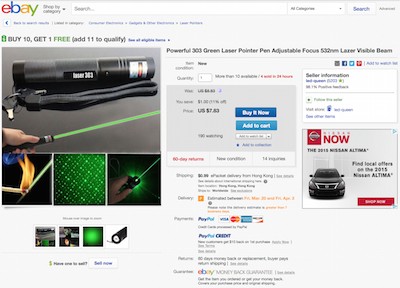Home
A comprehensive resource for safe and responsible laser use
US: UPDATED - 3 pilots go for eye treatment after multiple LaGuardia laser illuminations
On the evening of March 9, the Federal Aviation Administration notified the New York Police Department aviation department that someone was pointing laser beams at aircraft landing and taking off from LaGuardia Airport. A helicopter was dispatched to try and “draw fire.” Nothing happened for about 20 minutes, until the helicopter flew a path similar to an aircraft landing approach. On the second pass, a laser was aimed at the helicopter.
Both pilots were hit. Said one, “You feel a strong tingle in your eyes. You have a burnt spot where you can’t see. It is very dangerous for any pilot to be blinded.”
Ground officers went to the apartment of Frank Egan, 36. His mother invited the officers inside, where they found a device labeled “Laser 303.” According to police, Egan admitted using the laser pointer. He said it was purchased for $50 in an Orlando shop while on vacation.
He was charged with assault on a police officer, felony assault, menacing a police officer, reckless endangerment, and criminal possession of a weapon.
The next day, March 10, Egan told reporters that he did not aim the beam and that he was sleeping at the time of the incident.
From NBC 4 New York, the New York Post and the New York Times
UPDATED March 14 2015: Frank Egan’s roommate and brother-in-law, Elehecer Balaguer, 54, claimed that he was the one using the laser pointer. According to the New York Times, Balaguer swore an oath in New York State Supreme Court on March 13 2015 that he, not Egan, was responsible: “Frank had nothing to do with it. I was the one that did it. It was just a kid thing. It was a stupid thing to do.” Balaguer first denied aiming at aircraft, then after being asked two more times, confessed “I pointed it at the plane, yes, thinking it was a …” and his voice trailed off. He then said “But I didn’t mean to hurt anybody.” According to Egan’s lawyer, Egan never told the police he used the laser, contrary to the police statement after Egan’s arrest. From the New York Times. A related article in the New York Times published March 12 2015 was entitled “Powerful Lasers Easy to Buy, Experts Say.” The New York Post called the laser “military-grade” and said it had been purchased while on vacation in Orlando.

Elehecer Balaguer in court
UPDATED March 17 2015: Balaguer was charged on March 16 2015 in federal court with aiming a laser pointer at an aircraft. This has a maximum penalty of five years in prison and a $250,000 fine. FAA officials said they had to redirect traffic in and out of LaGuardia on March 9 to avoid going over the Bronx, where Balaguer and Egan lived. Balaguer’s attorney said the suspect “uses methadone every day and takes medication for bipolar disorder”, and that he was “harmless”: “It was stupidity, not venality.” From the Wall Street Journal.
UPDATED May 5 2015: Balaguer pleaded guilty in U.S. District Court to aiming a laser pointer at an aircraft. He could face up to five years in prison. The judge said sentencing guidelines call for between 2 and 2 1/2 years. He said sentencing of Balauger would not be routine “Given his psychiatric history, given his apparent lack of any wrongful intent, I can see one set of arguments being made; on the other hand I can see a different set of arguments because of the danger presented,” said the judge. Sentencing was scheduled for September 9 2015. According to the New York Post, Balaguer is a disabled ex-heroin dealer who has a history of schizophrenia and left school after ninth grade. From CBS New York, the New York Post, and the New York Times.
UPDATED April 19 2019: Frank Egan received a $227,500 settlement from New York City. His lawsuit said police had falsely claimed that Egan had admitted to owning the laser found during the arrest. Egan said his picture was widely spread in the media, his reputation had suffered, and his wedding and honeymoon were disrupted by the arrest. A Law Department spokesman said "…it was in the city's best interest to settle this case." From the New York Daily News.
Discussion from LaserPointerSafety.com
On March 19 2015, ten days after the New York incident, an FAA spokesperson wrote to LaserPointerSafety.com saying “The FAA is unaware of any U.S. commercial pilot who has suffered permanent eye damage as a result of exposure to laser light when in the cockpit.” Presumably this would include the Jet Blue pilot. Below is more information about the laser used in the New York incident, its probable power range, and the distance at which the laser could cause changes to the retina.
The photo below shows the laser confiscated during the arrest:
A Google search on March 10 2015 for “laser 303” found a number of similar lasers on the Internet. One was for sale on eBay for $7.83 plus $0.99 shipping from Hong Kong. The item description says that the laser is 532 nm (green) with an output of less than 1 milliwatt. However, it also states that the beam can burn a black match, which indicates a higher power — perhaps around 50-100 milliwatts.
To find out at what distance this laser could change or injure a person’s eyes, we start by calculating the Nominal Ocular Hazard Distance. For a visible-wavelength laser this depends on the laser’s output power, beam diameter and spread (divergence), as well as the exposure time. We will use the following parameters:
- Laser output power: Unknown, lowest stated by the website is 1 milliwatt; more likely is 50 or 100 milliwatts.
- Beam diameter: Unknown so we will use a small (tight) diameter of 1 millimeter
- Beam divergence: Unknown, but for lasers like this 1 milliradian is a conservative (safe) estimate.
- Exposure time: We use the standard 1/4 second exposure time, determined by laser safety scientists to be longer than a person’s “aversion response” where they involuntarily blink and/or turn away from a bright light.
Given these parameters, here is the Nominal Ocular Hazard Distance (NOHD) for three possible powers of the “Laser 303”:
- 1 milliwatt: 23.2 feet
- 50 milliwatts: 164 feet
- 100 milliwatts: 232 feet
The NOHD has a built in “safety factor” or “reduction factor.” An approximate description is: “At 1/3 of the NOHD, when the laser and the eyeball are fixed in position in a laboratory setting, there is a 50 percent chance of causing the smallest medically detectable change to the retina. Further from this point (the last 2/3 of the NOHD), the chance of even a minor change is less than 50 percent in most people. Beyond the NOHD, the chance of even a minor change is vanishingly small.”
So, in a situation where the laser exposure can be controlled, a person should not have their eye exposed closer than the NOHD. This is safe, and has a built-in safety factor.
However, if someone like a pilot has an unwanted exposure, they should be aware that being at or inside the NOHD does not mean instant or certain retinal injury. The closer one is to the laser, the greater the chance of the smallest medically detectable change to the retina. At 1/3 of the NOHD, there is a 50% chance, under laboratory conditions, of the laser causing the smallest medically detectable change to the retina. This change may be temporary — it will heal just like a skin burn — or it may be permanent especially as one continues to get closer to the laser source.
For the powers given above, here is the 1/3-of-the-NOHD distance at which 50% of the time there is likely to be a detectable change to the retina under laboratory conditions where the laser and eyeball are fixed relative to each other:
- 1 milliwatt: 7.7 feet
- 50 milliwatts: 55 feet
- 100 milliwatts: 77 feet
The chance of eye injury to the NYPD and AirCanada pilots depends on how close they were to the laser that was aimed at them, and of course to the actual output power and characteristics of the laser. The above figures are estimates based on powers of similar lasers sold on the Internet.

